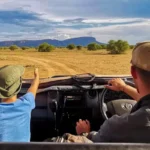South Africa Destinations
- Home
- South Africa Destinations
About South Africa
A South African safari is known for its accessibility, excellent infrastructure, and a variety of safari experiences to suit every budget and travel style. The country’s commitment to conservation has created a network of world-class national parks and private game reserves where wildlife thrives.
The most popular safari destination is Kruger National Park, an enormous and iconic park that offers both public-access and private luxury safari experiences. Beyond Kruger, other notable safari destinations include the Sabi Sands Game Reserve, Madikwe Game Reserve, and Hluhluwe-iMfolozi Park, each with its own unique appeal and wildlife.

What Activities To Do
A South African safari offers a wide variety of experiences beyond traditional game drives. Expert-led drives in open 4x4s bring you close to wildlife during peak activity hours, while guided bush walks reveal the smaller wonders of the ecosystem. For something truly unique, sunrise hot air balloon safaris provide sweeping aerial views, ending with a champagne breakfast.
Night drives offer a chance to spot elusive nocturnal creatures like leopards and civets. Many lodges also offer hands-on conservation activities, from rhino monitoring to anti-poaching initiatives. To complete the journey, cultural immersion with local communities, such as the Zulu, provides insight into traditions and heritage.

What To See
South Africa is a true wildlife paradise, offering the chance to see the Big Five—lion, leopard, rhino, elephant, and buffalo—along with giraffes, zebras, cheetahs, wild dogs, and countless antelope species. Birdlife is equally impressive, with over 800 recorded species across the country’s diverse national parks.





Best Time To Visit
The best time for a South African safari is the dry winter season (May–October), when sparse vegetation and waterhole gatherings make wildlife easier to spot. The wet season (November–April) brings lush landscapes, newborn animals, and exceptional birdwatching, though dense bush makes sightings harder. Lodges often offer lower rates.
How to Get Here
South Africa’s main entry points are O.R. Tambo International (Johannesburg) and Cape Town International. For Kruger, fly from Johannesburg to Skukuza or Kruger Mpumalanga, or self-drive in 4–5 hours. Many private reserves also feature airstrips, with charter flights available from Johannesburg and other major cities for convenience.

Exclusive Tour & Travel Packages
Experience the thrill of spotting the Big Five, explore diverse landscapes, and immerse yourself in rich cultures on an unforgettable South African safari adventure.
- 6 Nights - 7 Days
- 4 Nights - 5 Days
- 8 Nights - 9 Days
Where to Stay
South Africa’s safari accommodations range from budget-friendly rest camps to world-class luxury lodges. Luxury options like Singita, &Beyond, and Lion Sands offer private villas, gourmet dining, and guided safaris. Mid-range lodges such as Kapama River Lodge and Rhulani balance comfort and value, while SANParks’ Kruger rest camps provide affordable, self-catering stays.
Frequently Asked Questions
Yes. While like any country it has its challenges, tourist areas and safari destinations are very safe. It's always wise to be aware of your surroundings, but by following local advice and taking standard precautions, you will have a safe and memorable trip.
Visa requirements depend on your nationality. Many countries, including the USA, UK, and most of Europe, do not require a visa for stays of up to 90 days. It's best to check with your local South African embassy or consulate before you travel.
Neutral-colored clothing (khaki, brown, tan) is best to blend in with the environment. Pack layers for fluctuating temperatures, especially during early morning and evening game drives. A hat, sunglasses, sunscreen, insect repellent, and a good pair of binoculars are essential.
Many lodges and camps are family-friendly and offer special activities for children. Some private reserves have age restrictions on game drives, so it's important to check this in advance.
The cost varies widely based on the level of luxury, the duration of the trip, and the number of people. A budget safari can be done for a few hundred dollars per person per night, while a luxury experience can cost thousands.
Real Stories from Happy Travelers
Hear from our happy travelers as they share their unforgettable experiences and cherished memories from their journeys.
We had the best time with Little Rock Safari! It totally exceeded our expectations. Right from the start, the staff was so friendly

Canada
Where to begin!?!? My husband and I did a two day Murchison falls safari trip, with Cliff & Derrick as our guides.

Traveler
Memorable Safari experience from start to the end I contacted Little Rock Safaris about 4 and half months before the tour starting date.
Traveler
Our original tour operator canceled our trip at last minutes, so we contacted Littlerock safaris to replace our canceled tour and they responded to us immediately
Adventure Awaits – Book Your Journey Today
Step into a world of unforgettable adventures with EpicEscapes. we make every journey seamless and extraordinary.

Littlerock Safaris & Events Ltd is a well-established tour, travel and Events Company with over 15 years of experience in handling inbound and outbound holidays.
Contact Info
Our Address
UK MALL, Kampala, Ugandax
Our Phone
+256 772 758055
+256 706 758055
Our Email
info@littlerocksafaris.com
Trusted Partners




Copyright © 2025 Littlerock Safaris . All Rights Reserved Designed by Safari Marketing Pro
Little Rock Safaris is proudly powered by WordPress








Oaklee H
USA